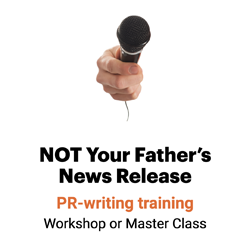They chew gum, don’t they?

Famous story about a pitch gone bad:
A PR pro at Warner-Lambert Company calls an editor at Inc. magazine. When, she asks, is Inc. going to run that story she pitched on W-L’s new flavor of Trident gum?
The editor explains that Inc. is a magazine for entrepreneurs and that every story the magazine runs is designed to help its readers build their businesses. Given that, the editor asks the PR pro, why would our readers be interested in a story about Trident?
The PR pro replies: “They chew gum, don’t they?”
With pitches like these, it’s no wonder journalists’ biggest pet peeves are releases that aren’t relevant to the audiences they serve, according to a survey by Greentarget.
So how can we write relevant releases?
1. Write about the reader.
A few years ago, the St. Louis Post-Dispatch did a study to learn who or what was most important to readers.
“What I really like about a [release] is when it scratches my reader’s itch and not your client’s itch.”
— Trade journal editor quoted in Public Relations Tactics
“Their answer was in some ways surprising. Many did not say their families, children or God,” writes Dick Weiss, former writer and editor for the St. Louis Post-Dispatch. “Instead, their answer was: ‘Me.’”
If that’s what reporters’ readers care about, that’s what reporters care about too.
“What I really like about a [release],” says a trade journal editor quoted in Public Relations Tactics says, “is when it scratches my reader’s itch and not your client’s itch.”
So write about the reader. Not about “us and our stuff.”
2. Offer value-added service stories.
More than half of business-to-business editors surveyed seek more feature releases, according to a study by Thomas Rankin Associates. Those include value-added stories like case studies and how-to stories.
“Present the key element … that explains how your story can benefit Forbes readers.”
— Bruce Upbin, senior editor at Forbes
Greentarget learned the same thing in its study: Journalists find releases that contain thought leadership — surveys, tipsheets, case studies, etc. — most valuable.
As Bruce Upbin, senior editor at Forbes, counsels: “Present the key element … that explains how your story can benefit Forbes readers.”
That’s write about the reader.
And yet, PR pros persist in writing about themselves.
“Organizations write press releases for themselves, not for readers.”
— A frustrated PR pro
“I recently got a message from a reporter working at a small local paper who received 80 press releases in one day,” writes digital communications strategist Jeremy Porter, “of which only two were relevant to the information his paper covers.”
Keep doing this, and we’ll be as successful as Warner-Lambert with its Inc. pitch.
Even if they do chew gum.
Pitch a story, not a product
It may be my favorite pitch lead of all time:
This Korbel pitch — a PRSA Silver Anvil Award winner — sells a story, not sparkling wine. And that’s what you want to do, too.
The writer goes on to offer:
- A timely angle(more people get engaged on Valentine’s Day than on any other day of the year
- A helpful tipsheet(“Top Ten Signs He’s about to Pop the Question”)
- Provocative story angles(a “be prepared” piece, an article telling men how to avoid giving away the big surprise, the results of a proposal survey, an interview with an “engagement expert.”)
Then contact information and a signoff — “Cheers!” of course.
Take a tip from Korbel: Use your pitch to sell a story, not your product. Focus on entertainment, a benefit to the reader or a timely survey. Don’t just pitch a commercial.
Write a story, not a sales piece.
To make sure your pitch is relevant to reporters and their readers:
- Find a poster child.Instead of writing about your product, service or issue, write about someone who’s affected by it.
- Focus on what your spokesperson will say.Instead of running a lengthy bio, pre-interview your subject matter expert. Does she have a contrarian opinion or offer a fresh point of view? That — and not a list of which boards she sits on — is the story.
- Leave your company name out of the headline. Newspapers rarely put company or product names in headlines. To do so on your pitch “shouts to the journalist that this is a commercial for blank,” says Jeff Crilley, founder of Real News PR and author of Free Publicity.
- Skip the trademark symbols and repeated capitalized product and company names. They’re not necessary in an informal emailed pitch, and they scream “commercial,” says Michael Schiferl, senior vice president/director of media relations for Weber Shandwick Worldwide.
- Focus on the story.“Go buy a bunch of the current magazines in the field, peruse those, get in the mindset of the editor and see how things are framed,” advises NASA PR pro Nicole Cloutier. “Then step away and let it gel.”
NASA pitches space food.
That approach allows NASA’s Cloutier to go beyond “what’s happening tomorrow” by digging up real stories like this one for media pitches:
I don’t know, but I can’t wait to find out. Because it’s a story, not a commercial.
____
Source:
“Perfect Email Pitches: Master PR Scribes Reveal How to Craft Copy That Turns Heads and Earns Media Ink,” Bulldog Reporter’s PR University teleseminar, Sept. 18, 2008

Leave a Reply